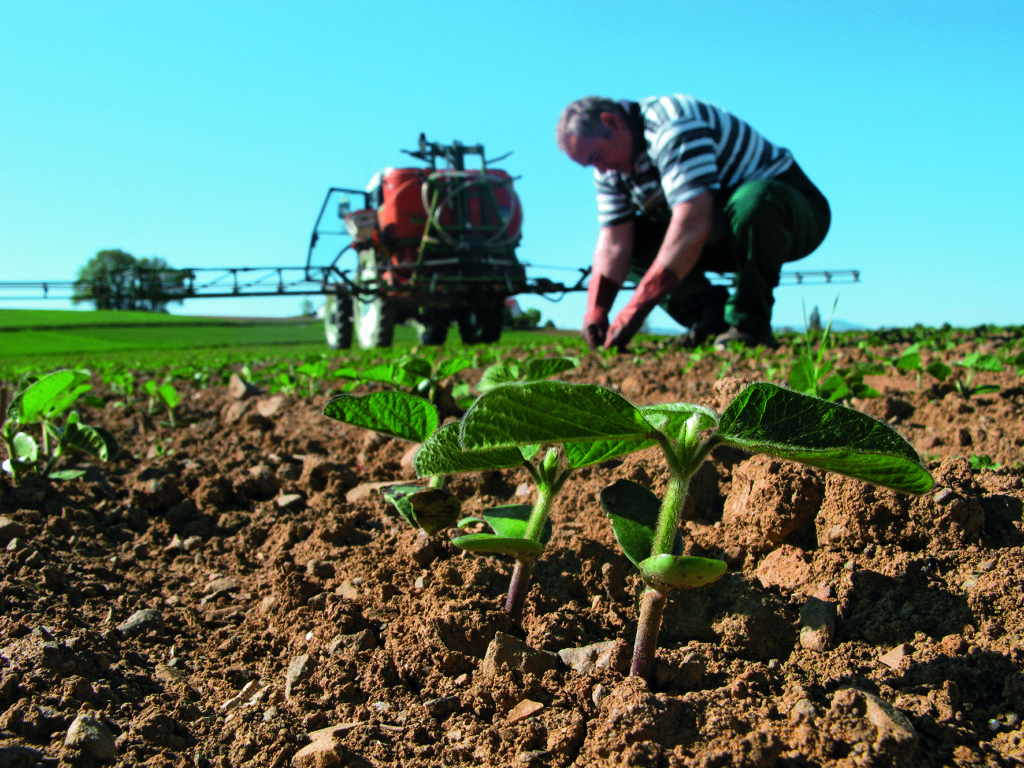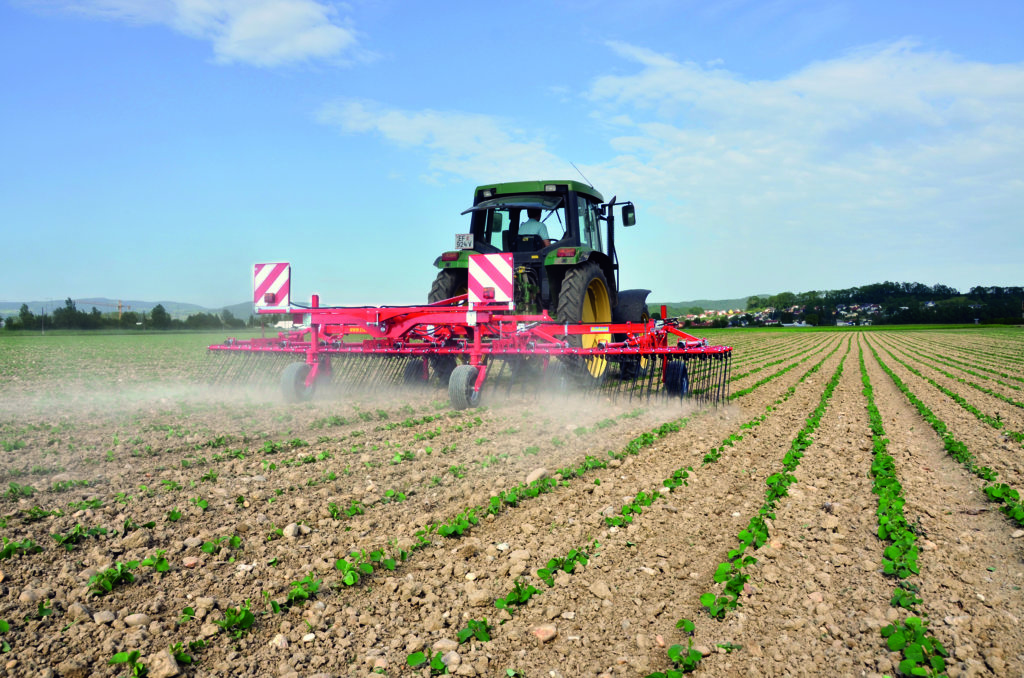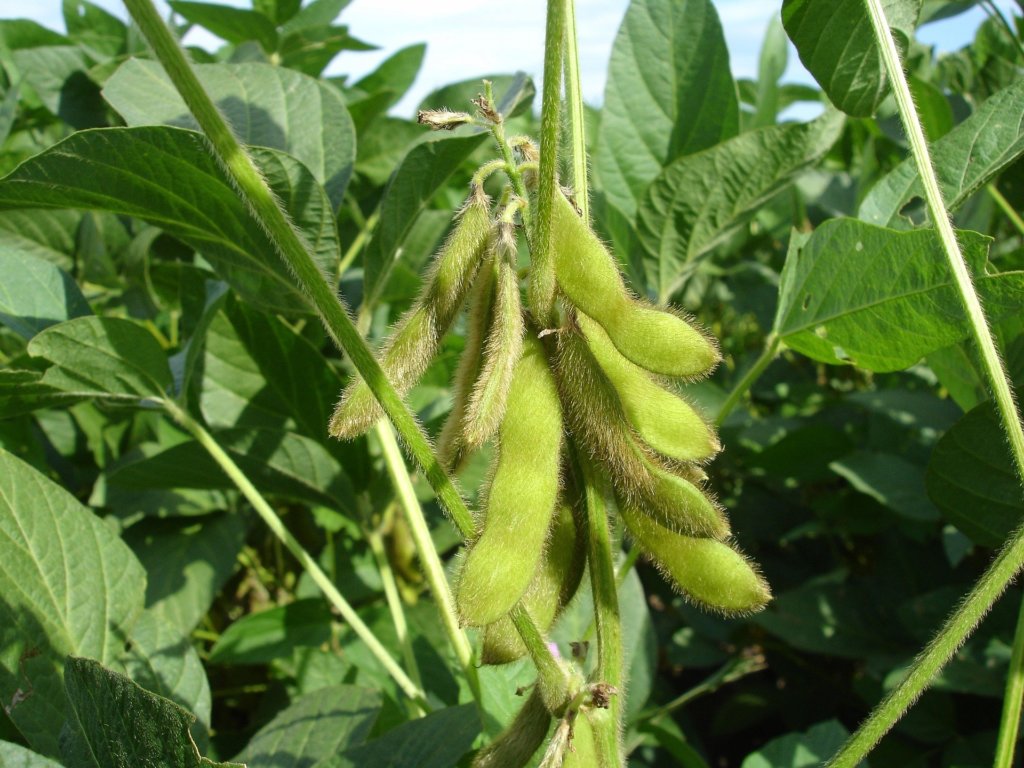Weed control in soybean cultivation
Chemical weed control
Effective weed control is critical to the success of the crop, as soybean has little competitive strength against weeds due to its slow youth development and late stand closure. In addition, excessive weed presence can complicate harvesting operations, contribute to increased yield moisture and massively affect the quality of the product harvested.
What promotes good weed suppression:
- Varieties with rapid youth development
- Branching varieties with broad leaves
- Long-straw varieties with abundant biomass growth
- Caution: These varieties usually have poor stability! (No problem in dry areas, but disadvantageous in humid regions)
- No large row widths – better drill sowing
- The seed rate should not be too low!
- Correct sowing time: The aim is rapid field emergence and rapid youth development.
On the one hand, the soybean hardly tolerates weed competition and reacts with strong yield drops, like for example sugar beet. On the other hand, the soybean plant is sensitive to the herbicides used and can react with lower yields if the application rates are not adapted to the specific conditions.
When sowing, ensure a sufficient depth of at least 3, preferably 4 cm and a closed seed furrow to guarantee compatibility when using soil herbicides. Attention should also be paid to a fine-crumbled seedbed. Large lumps of soil can seriously interfere with the effect of the soil herbicides. In this case, the use of a roller before applying the crop protection is useful. This not only improves the herbicide effect, but also makes harvesting easier because of the deep pod base of the soybean.
Pre-emergence application: Standard
The leading weed Chenopodium can only be reliably controlled by pre-emergence spraying.
 Proven pre-emergence herbicide strategies:
Proven pre-emergence herbicide strategies:
• Pre-emergence: Broad spectrum of mixed weeds, with millet and Solanum, somewhat weaker for Chenopodium: 0.3-0.4 l/ha Sencor Liquid + 0.25 l/ha Centium 36 CS + 0.6-0.8 l/ha Spectrum
• Pre-emergence:Broad spectrum of mixed weeds, especially strong for Chenopodium, without Solanum: 1.5-2.0 kg/ha Artist + 0.25 l/ha Centium 36 CS
Important: The upper application rates are valid for clay and/or soil rich in humus (clay; loamy clay) or drier conditions, the lower application rates are valid for light soils (sandy loam; pure, low humus silt) or humid conditions. The herbicides should be sprayed after sowing in pre-emergence until shortly before the beans emerge. At the time of the herbicide application the soil should be as humid as possible. The seed must be placed at least 3-4 cm deep and the seed row must be closed!
In the category of pre-emergents, the Spectrum Aqua Pack with 0.75 l/ha Spectrum and 1.5 l/ha Stomp Aqua are available (or the ready-to-use mixture Spectrum Plus with 2.75 l/ha). The effect against Chenopodium species is quite reliable, but the tolerance risk of the active ingredient pendimethalin must be taken into account. Particularly on lighter soils, but especially after heavy rainfall, there may be damage to the soybean, sometimes even plant losses. If the use of Stomp Aqua (or Spectrum Plus) is intended, at least the following points should be observed:
- The Stomp Aqua quantity should be limited to 1.5 l/ha (although 2.6 l/ha would be permitted).
- Spectrum Plus should only be applied at 2.75 l/ha (although 4 l/ha would be permitted).
- Sowing must be carried out precisely with a minimum sowing depth of 5 cm.
Post-emergence treatment – only if necessary:
If a long drought after pre-emergence spraying has led to insufficient weed control, a post-emergence treatment must be used. If the soybean is in an oilseed rape rotation and the dropped seeds of oilseed rape have already emerged, a post-emergence treatment is often unavoidable, as all pre-emergence active substances have a gap in efficacy against dropped seeds of oilseed rape. Post-emergence treatments are only useful for the secondary control of weeds that may not have been covered by the pre-emergence treatment. Weed control in post-emergence alone is not possible.
Harmony SX can be applied in the post-emergence procedure twice in splitting up to BBCH 14 (leaves unfolded on the 4th nodium) of the soybean. The first treatment can be applied with 7.5 g/ha Harmony SX + additive until BBCH 12 of the weeds. After 7-14 days a second treatment with 7.5 g/ha Harmony SX + additive is possible until BBCH 14 of the weeds.
Important for good tolerance:
Harmony SX intervenes as a sulfonylurea in the metabolism of the soybean and must be metabolised. This only succeeds when weather conditions are favourable for growth. Under cool conditions, the growth of the soybean may be delayed. The use of an additive to open the waxy layer on the leaves of the weeds for Harmony SX is very important for a reliable effect. The product Dupont Trend (0.3 l/ha), for example, has proven itself in practice. Other additives would also be possible. Also possible is Clearfield Clentiga, which has been approved in soybeans since 2018. It is used in post-emergence with an application rate of 1 l/ha Clearfield Clentiga + 1 l/ha Dash. Initial experience from the 2018, 2019 and 2020 seasons is quite promising if applied in time. Care should be taken that the weeds have not grown significantly beyond the first leaf stage. A good effect against Galium, Brassicaceae, Solanum, Lamium, Chenopodium and Persicaria is ensured. In the last two years, the combination of 1 l/ha Clearfield Clentiga + 1 l/ha Dash + 7.5 g/ha Harmony SX has proven its effectiveness in practice. If good weather conditions were taken into account, there were hardly any compatibility problems. If grasses, but especially millet, are still present, a grass treatment with 0.8-1.0 l/ha Fusilade Max or 1.5-2.0 l/ha Focus Ultra + Dash can be carried out. However, this should be done in a separate operation in order not to run an unnecessary compatibility risk. These grass products also cover larger millet plants safely, provided that sufficient leaf mass is sprayed.
Insecticide treatment
-
- Insecticide treatment is usually not necessary.
- Exception: If the Vanessa cardui butterfly occurs, 75 ml/ha of Karate Zeon must be applied after the damage threshold has been reached.
Mechanical weed control
Conventional cultivation with herbicide use
Mechanical weed control using a hoe can also be carried out in conventional cultivation if necessary. In addition to weed control, mechanical treatment favours gas exchange and thus the development of nodule bacteria. However, it must be mentioned as a disadvantage that the herbicide layer of the pre-emergence treatment is destroyed. To avoid late weeding, hoeing should take place as late as possible. The row distance at sowing must be appropriate for the machine hoe.
Organic cultivation without the use of chemical herbicides
If weed control is to be carried out purely mechanically, some important points must be taken into account. Shallow tillage a few weeks before sowing is essential. Creating a so-called “false seedbed” will cause the first weeds to emerge, which are then destroyed with the actual seedbed preparation.
 Due to the slow youth development, several applications with harrow and hoe are essential. Already a few days after sowing, the so-called “blind harrowing” is necessary before the soybean emerges. The sowing depth should be somewhat deeper, approx. 5 cm, to avoid damage. Precise depth control of the harrow must be ensured. If possible, do not harrow during field emergence to avoid losses. Harrowing can be resumed from the 3rd pair of leaves. For a better tolerance of the harrowing, the implementation from late morning onwards when the plants are more flexible has proven to be successful. During emergence, between the rows the first machine hoe (with hollow discs) should be applied as early as possible. In general, a second, third or fourth hoeing pass will be necessary within the first 4 to 6 weeks after sowing. During the third and/or fourth hoeing pass, the weeds in the soybean row should be controlled with a torsion hoe (a spring-loaded tine working on both sides of the crop row and slightly cranked at the end), finger hoe (fingers dig into the rows laterally) or flat hoe.
Due to the slow youth development, several applications with harrow and hoe are essential. Already a few days after sowing, the so-called “blind harrowing” is necessary before the soybean emerges. The sowing depth should be somewhat deeper, approx. 5 cm, to avoid damage. Precise depth control of the harrow must be ensured. If possible, do not harrow during field emergence to avoid losses. Harrowing can be resumed from the 3rd pair of leaves. For a better tolerance of the harrowing, the implementation from late morning onwards when the plants are more flexible has proven to be successful. During emergence, between the rows the first machine hoe (with hollow discs) should be applied as early as possible. In general, a second, third or fourth hoeing pass will be necessary within the first 4 to 6 weeks after sowing. During the third and/or fourth hoeing pass, the weeds in the soybean row should be controlled with a torsion hoe (a spring-loaded tine working on both sides of the crop row and slightly cranked at the end), finger hoe (fingers dig into the rows laterally) or flat hoe.
Source: Jürgen Unsleber, plant cultivation adviser at LKP

